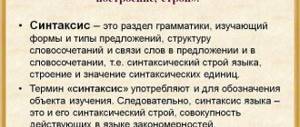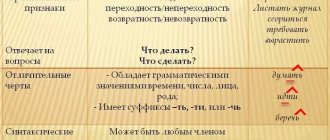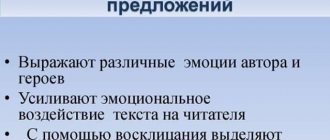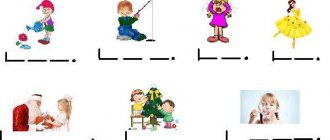Parsing diagram for a simple sentence
If you need to parse a simple sentence, we recommend following this pattern :
- find and emphasize the grammatical basis;
- determine how the main terms are expressed;
- emphasize the minor members, first asking questions about them; determine which part of speech they are expressed by;
- characterize the proposal; if necessary, draw up a diagram (for example, homogeneous members).
Let's look at how to perform these parsing elements.
In a compound sentence:
First, we indicate which sentence according to the purpose of the statement is interrogative, declarative or motivating. We find simple sentences in the sentence and highlight the grammatical basis in them.
We find conjunctions that connect simple sentences into complex ones. We note what kind of conjunctions they are - adversative, connecting or disjunctive. We determine the meaning of this entire complex sentence - opposition, alternation or enumeration. We explain why the punctuation marks are placed in this way in the sentence. Then each simple sentence that makes up a complex sentence must be parsed in the same way as a simple sentence is parsed.
How to find a grammatical basis
The search for the main members can begin with both the subject and the predicate.
There is a special – predicative – connection between the subject and the predicate; You can pose a question both from the subject to the predicate, and from the predicate to the subject.
The subject is most often expressed by a noun or pronoun in the nominative case, a combination of a cardinal number with a noun, a syntactically indivisible combination; less often - an infinitive or cardinal number. The first rays are common; children become acquainted with them already in the 5th grade.
The predicate can be expressed by any part of speech, except the gerund, a phraseological unit, or a syntactically indivisible combination. It may be
- simple verb (one verb: “the cat is sleeping”)
- compound verb (infinitive plus a phase or modal verb in personal form or a short adjective with a modal meaning: “I was glad to help”)
- compound nominal (the connective “to be” or the semi-connective “to become, to seem”, etc. plus the nominal part: “the bench is painted”)
In a complex sentence with subordinate clauses (several)
We call what a sentence is according to the purpose of the statement. We highlight the grammatical basis of all simple sentences that make up a complex sentence and read them out. We indicate which sentence is the main one and which is the subordinate clause. It is necessary to indicate what the subordination in the sentence is - either it is parallel subordination, or sequential, or homogeneous. If there is a combination of several types of subordination, this must be noted. We explain why punctuation marks are placed in this way in the sentence. And, at the end, we analyze the subordinate and main clauses as simple sentences.
Minor members
If there are no minor members, the proposal is not extended. If there is, it is widespread, and the minor members must be emphasized:
- addition - dotted line;
- definition – wavy line;
- circumstance – “dot – dash”.
The same member of a sentence can sometimes be considered both as a circumstance and as an addition (sometimes as a definition and as an addition); in such a situation, it is better to write a question above the word: where is the vase? on the shelf - circumstance, on what? on the shelf - an addition.
In a complex sentence with a subordinate clause (one)
First, we indicate what the sentence is according to the purpose of the statement. We highlight the grammatical basis of all simple sentences that make up a complex sentence. Let's read them out.
We name which sentence is the main one and which is the subordinate one. We explain what kind of complex sentence it is, pay attention to how it is constructed, how the subordinate clause is connected to the main sentence and what it refers to.
We explain why punctuation marks are placed in this way in this sentence. Then, the subordinate and main clauses must be parsed in the same way as simple sentences are parsed.
Syntactic analysis of a simple sentence has become firmly established in the practice of primary and secondary schools. This is the most difficult and voluminous type of grammatical analysis. It includes the characteristics and outline of the sentence, analysis by members indicating parts of speech.
The structure and meaning of a simple sentence is studied starting from the 5th grade. The full set of features of a simple sentence is indicated in the 8th grade, and in the 9th grade the focus is on complex sentences.
In this type of analysis, the levels of morphology and syntax are correlated: the student must be able to identify parts of speech, recognize their forms, find conjunctions, understand how words are connected in a phrase, know the signs of the main and minor members of a sentence.
Let's start with the simplest thing: we will help the children prepare for parsing in 5th grade. In elementary school, the student remembers the sequence of parsing and performs it at an elementary level, indicating the grammatical basis, syntactic connections between words, the type of sentence according to the composition and purpose of the statement, learns to draw up diagrams and find homogeneous members.
In elementary schools, different Russian language programs are used, so the level of requirements and student preparation are different. In the fifth grade, I accepted children studying in elementary school under the programs of the educational system “School 2100”, “School of Russia” and “Primary School of the 21st Century”. There are also big differences. Primary school teachers do a tremendous amount of work to compensate for the shortcomings of their textbooks, and they themselves “create” continuity between primary and secondary schools.
In grade 5, the material on sentence analysis is generalized, expanded and built into a more complete form; in grades 6-7 it is improved taking into account newly studied morphological units (verb forms: participle and gerund; adverb and state category; function words: prepositions, conjunctions and particles ).
Let us show with examples the differences between the level of requirements in the parsing format.
| In 4th grade | In 5th grade |
| In a simple sentence, the grammatical basis is highlighted, familiar parts of speech are indicated above the words, homogeneous members are emphasized, phrases are written out, or syntactic connections between words are drawn. Scheme: [O -, O]. Declarative, non-exclamatory, simple, common, with homogeneous predicates. Noun (main word) + adj., Ch. (main word) + noun. Ch. (main word) + place. Adverb + verb (main word) | Syntactic connections are not drawn, phrases are not written out, the scheme and basic notations are the same, but the characteristics are different: narrative, non-exclamatory, simple, two-part, common, complicated by homogeneous predicates. Analysis is constantly practiced in lessons and participates in grammatical tasks in control dictations. |
| In a complex sentence, the grammatical basics are emphasized, the parts are numbered, familiar parts of speech are signed over the words, the type is indicated according to the purpose of the statement and emotional coloring, according to the composition and presence of minor members. Parsing scheme: [O and O]1, [ ]2, and [ ]3. Narrative, non-exclamatory, complex, widespread. | The scheme remains the same, but the characteristics are different: narrative, non-exclamatory, complex, consists of 3 parts that are connected by a non-union and union connection, 1 part has homogeneous members, all parts are two-part and widespread. Analysis of a complex sentence in grade 5 is for educational purposes and is not a means of control. |
| Sentence patterns with direct speech: A: “P!” or "P," - a. The concept of quotation is introduced, which coincides in design with direct speech. | The diagrams are supplemented by a break in direct speech with the words of the author: “P, - a. - P." and “P, - a, - p.” The concept of dialogue and ways of its design are introduced. Schemes are drawn up, but sentences with direct speech are not characterized. |
Plan for parsing a simple sentence
1. Determine the type of sentence according to the purpose of the statement (narrative, interrogative, incentive).
2. Find out the type of sentence by emotional coloring (non-exclamatory or exclamatory).
3. Find the grammatical basis of the sentence, underline it and indicate the methods of expression, indicate that the sentence is simple.
4. Determine the composition of the main members of the proposal (two-part or one-part).
5. Determine the presence of minor members (common or non-common).
6. Emphasize the minor members of the sentence, indicate the ways of their expression (parts of speech): from the composition of the subject and the composition of the predicate.
7. Determine the presence of missing members of the sentence (complete or incomplete).
8. Determine the presence of a complication (complicated or not complicated).
9. Write down the characteristics of the proposal.
10. Create an outline of the proposal.
For analysis, we used sentences from Sergei Kozlov’s wonderful fairy tales about the Hedgehog and the Little Bear.
1) It was an extraordinary autumn day!
2) Everyone’s duty is to work.
3) Thirty mosquitoes ran out into the clearing and began to play their squeaky violins.
4) He has neither a father, nor a mother, nor a Hedgehog, nor a Bear.
5) And Belka took some nuts and a cup and hurried after.
6) And they put things in a basket: mushrooms, honey, a teapot, cups - and went to the river.
7) Pine needles, fir cones, and even cobwebs - they all straightened up, smiled and began to sing with all their might the last autumn song of the grass.
 The Hedgehog lay there, covered up to his nose with a blanket, and looked at the Little Bear with quiet eyes.
The Hedgehog lay there, covered up to his nose with a blanket, and looked at the Little Bear with quiet eyes.
9) The hedgehog sat on a hill under a pine tree and looked at the moonlit valley, flooded with fog.
10) Across the river, the forest was dark, blazing with aspens.
11) So until the evening they ran, jumped, jumped off the cliff and screamed at the top of their lungs, setting off the stillness and silence of the autumn forest.
12) And he jumped like a real kangaroo.
13) Water, where are you running?
14) Maybe he's gone crazy?
15) It seems to me that he imagined himself... as the wind.
Examples of parsing simple sentences
in .doc format 75.5 KB
In a complex non-union sentence:
We call what a sentence is according to the purpose of the statement. We find the grammatical basis of all the simple sentences that make up this complex sentence. We read them out and name the number of simple sentences that make up a complex sentence. We determine the meaning of the relationships between simple sentences. It can be sequence, cause and effect, opposition, simultaneity, explanation or addition.
We note what the structural features of this sentence are, what kind of complex sentence it is. How are the primes connected in this sentence and what do they refer to.
We explain why the punctuation marks are placed in this way in the sentence.
In a complex sentence in which there are different types of connections.
We call what purpose the sentence is in terms of the purpose of the statement. We find and highlight the grammatical basis of all simple sentences that make up a complex sentence, and read them out. We establish that this proposal will be a proposal in which different types of communication are present. Why? We determine what connections are present in this sentence - conjunctional coordinating, subordinating or any others.
By meaning, we establish how simple ones are formed in a complex sentence. We explain why punctuation marks are placed in the sentence in this way. We parse all the simple sentences from which a complex sentence is composed in the same way as a simple sentence.
Everything for studying » Russian language » Parsing sentences





